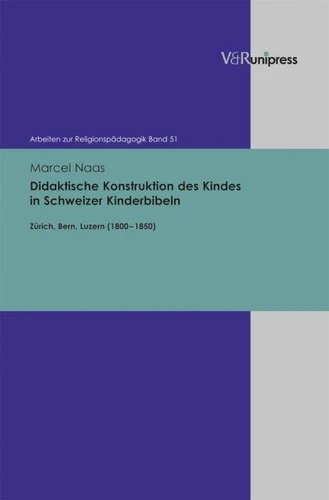Didaktische Konstruktion des Kindes in Schweizer Kinderbibeln. Zürich, Bern, Luzern (1800–1850)
Par : , , ,Formats :
Disponible dans votre compte client Decitre ou Furet du Nord dès validation de votre commande. Le format PDF est :
- Compatible avec une lecture sur My Vivlio (smartphone, tablette, ordinateur)
- Compatible avec une lecture sur liseuses Vivlio
- Pour les liseuses autres que Vivlio, vous devez utiliser le logiciel Adobe Digital Edition. Non compatible avec la lecture sur les liseuses Kindle, Remarkable et Sony
 , qui est-ce ?
, qui est-ce ?Notre partenaire de plateforme de lecture numérique où vous retrouverez l'ensemble de vos ebooks gratuitement
Pour en savoir plus sur nos ebooks, consultez notre aide en ligne ici
- Nombre de pages403
- FormatPDF
- ISBN978-3-86234-975-3
- EAN9783862349753
- Date de parution04/10/2012
- Protection num.pas de protection
- Taille2 Mo
- Infos supplémentairespdf
- ÉditeurV&R Unipress
Résumé
Children's bibles are a forgotten source in historical research on education. Nevertheless, they have been used in schools and families for centuries and their selected stories, the way of presenting them to children, and the use of language give evidence on the author's implicit perception of the child. The presented work focuses on historical children's bibles that were used in schools of exemplary chosen Swiss cantons between 1800 and 1850 to analyze their didactical constructions.
Selected bible stories as "the fall of man", "Sodom and Gomorrha", "David and Bathseba" or the "Sufferings of Jesus Christ" show how differently these stories were written. Topics like moral, sin, violence, sexuality, the way of treating wonders, or the implementation of scientific knowledge in children's bibles are analyzed to extract the didactical construction of the child. The results include some general tendencies concerning the change of the perception of the child within the analyzed time span as well as several interesting cantonal and confessional differences.
Selected bible stories as "the fall of man", "Sodom and Gomorrha", "David and Bathseba" or the "Sufferings of Jesus Christ" show how differently these stories were written. Topics like moral, sin, violence, sexuality, the way of treating wonders, or the implementation of scientific knowledge in children's bibles are analyzed to extract the didactical construction of the child. The results include some general tendencies concerning the change of the perception of the child within the analyzed time span as well as several interesting cantonal and confessional differences.
Children's bibles are a forgotten source in historical research on education. Nevertheless, they have been used in schools and families for centuries and their selected stories, the way of presenting them to children, and the use of language give evidence on the author's implicit perception of the child. The presented work focuses on historical children's bibles that were used in schools of exemplary chosen Swiss cantons between 1800 and 1850 to analyze their didactical constructions.
Selected bible stories as "the fall of man", "Sodom and Gomorrha", "David and Bathseba" or the "Sufferings of Jesus Christ" show how differently these stories were written. Topics like moral, sin, violence, sexuality, the way of treating wonders, or the implementation of scientific knowledge in children's bibles are analyzed to extract the didactical construction of the child. The results include some general tendencies concerning the change of the perception of the child within the analyzed time span as well as several interesting cantonal and confessional differences.
Selected bible stories as "the fall of man", "Sodom and Gomorrha", "David and Bathseba" or the "Sufferings of Jesus Christ" show how differently these stories were written. Topics like moral, sin, violence, sexuality, the way of treating wonders, or the implementation of scientific knowledge in children's bibles are analyzed to extract the didactical construction of the child. The results include some general tendencies concerning the change of the perception of the child within the analyzed time span as well as several interesting cantonal and confessional differences.













